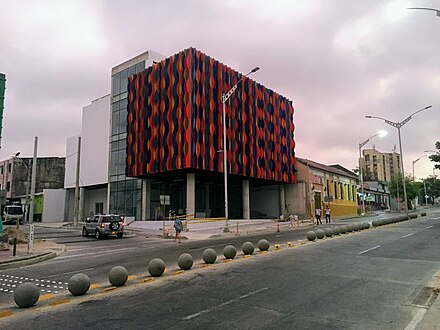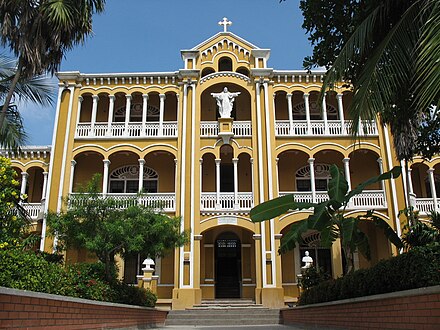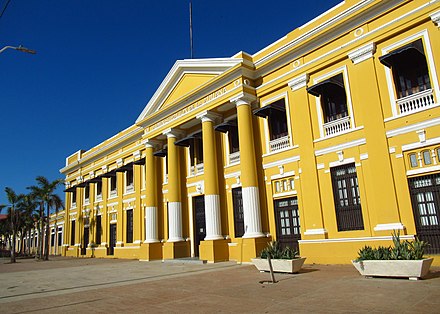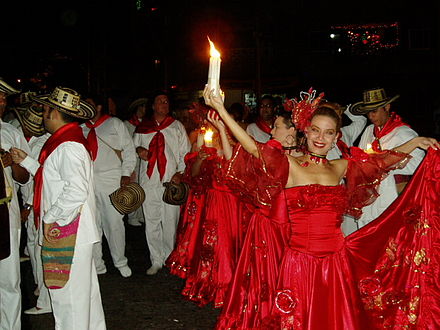Barranquilla - capital district of Atlántico Department in Colombia
 Barranquilla is a city on the Caribbean Coast of Colombia.
Barranquilla is a city on the Caribbean Coast of Colombia.
Understand
Barranquilla is a cosmopolitan and primarily industrial city, often visited by businessmen of all nationalities. However the main attraction for tourism is its carnival "Carnaval de Barranquilla," that takes place during the four days before Ash Wednesday. In November 2003, UNESCO proclaimed it as one of 28 different "masterpieces of the oral and intangible heritage of humanity".
Barranquilla is also called by its residents and Colombians in general "Curramba" (from a language game, in synthesis, Curramba is a reference to "party") and the Golden Gate to Colombia (Puerta de Oro de Colombia), this due to its location on the delta of the Magdalena river, making it the most important commercial sailing port to the Atlantic Ocean for the nation.
Residents are known as "Barranquilleros" and are characterized by their outgoing and friendly attitude and relaxed behavior. This makes the average barranquillero an optimistic and open individual, as well as goal-directed and hard-working.
Get in
By air
Visitors arrive to the city traditionally by plane. The airport "Ernesto Cortissoz" is on the far south side of the city. The fare is usually US$8–12 to get to the city center by taxi. Buses into the city depart in front of the terminal on the ground floor.
International direct flights are available to Fort Lauderdale, Miami and Panama City. Domestic non-stop flights arrive from Bogotá, Medellín and Cali.
Airport car rental services can be arranged from abroad with two main companies: Hertz and National Car Rental.
By bus
Buses run by the terminal as well and will get you into the city for $0.55 or less, with the drawback of a significantly less comfortable ride experience.
Barranquilla can also be a connection to other cities of the northern coast of the country, provided the traveler doesn't have a flight connection to anywhere else in Colombia already. Long-distance bus fares (in US dollars) to some cities are:
Since the bus station is quite far away from the city center, and since buses departing from there are generally slow and stop at every village, it might be a good option to travel with bus companies operating direct links to Cartagena, Bogotá or Santa Marta from around the city center. One of these is Berlinastur, departure to Cartagena or Santa Marta every hour, COP$16, terminal at calle 96 with carrera 46. To get there from the tramway system you can take Alimentador A-71 or A-94, and also many "unofficial" colectivos, ask people in the street.
Cochetur runs air conditioned van services for travel among Cartagena, Baranquilla, and Santa Marta. Price per person is around COP$25,000 and trip time to either of the other cities is around 2 hours.
Get around

Moving around in Barranquilla depends largely on the traveler's budget, language barriers and spirit of adventure.
Renting a car is an option for visitors with a more comfortable budget, the daily fare for an economy vehicle being around COP$150,000 a day, and with gasoline prices of about COP$8,000 per gallon (COP$2,100/L). However, driving in Barranquilla can be obviously tricky if you don't know your way around or the changes in traffic during rush hour. Rent a car services can be dealt with from abroad or upon arrival to the hotel, may that be the case.
Taking a taxi is by far the best option for the newcomer. As of January 2011, the minimum fare was COP$5,000. They may more a bit more expensive at night time, Sundays, on national holidays or during rush hour. Taxis in Barranquilla do not have a meter: The fare is decided by the driver on the basis of distance, travel time and daytime vs nighttime. The most you will ever be charged for an in town trip is COP$16,000.
For those with more spirit for adventure, buses are another option. In this case, talking to the driver may not be necessary, but knowing someone in town is definitely of great help when choosing the right route. Bus fares are COP$2,400 (Sept 2021) per ride, sometimes a little more if the bus is equipped with air conditioning (not all of them are). Moovit covers some bus lines. If you go to a main street and ask there somebody who waits for a bus, you increase your chance of finding a direct bus connection. Be warned that the buses do not wait until you are seated before they move and when getting off, often start back up before both your feet are on the ground when getting off. They also start and stop abruptly, so hang on.
Mototaxis are an illegal way of transportation that has grown in popularity. These consist of motorcycles charging significantly less money than a regular cab to take you virtually anywhere, but this mean of transportation is riddled with risks for personal safety, as these drivers have the tendency to be reckless.
Bicycle is an excellent way to get around town and popular with locals. You can rent a bike from Carliño Bicicletas on Calle 64 (south of Carrera 46). COP$3,000 per hour for a city bike, COP$5,000 per hour for mountain. Buying a bike is also an option. The Colombia HQ of Buffalo Bicycles (part of World Bicycle Relief NGO) is in Barranquilla at a warehouse on Calle 73 (north of Via 40). You can buy a new bike there for COP$700,000. Second-hand bikes can be found at several pawn shops in Centro district.
See

Every year by the end of February or early March (forty days before Ash Wednesday), Barranquilla hosts its famous "Carnaval de Barranquilla" (carnival of Barranquilla), a four-day-long celebration in which the true partying spirit of the city is unleashed. Parades, dances, concerts and many cultural manifestations take place all over town.
Barranquilla also houses the beautiful and famous Teatro Amira de la Rosa, the old Customs building-Edificio de la Aduana, that serves as library as well as a museum; the Museum of Gold; and many other great places to visit. There are also a large number of art deco buildings built from the late 1930s into the 1950s. (See the book Barranquilla-Ciudad Art Deco by Gustavo Garcia.)
- Museo del Caribe, Calle 36 No. 46-66, 10.986306°, -74.778450°, +57 5 372 0581. 9AM-5PM. A great collection of the history of Barranquilla and the Caribbean. Modern displays featuring immigration, native cultures, ecology, food and else. A special chamber dedicated to author Gabriel Garcia Marquez. Closed: first Monday of the month (Tuesday if Monday is a holiday). COP$10,000
- Castillo de Salgar, 11.018999°, -74.940512°. There is an attractive colonial-era building in the nearby town of Salgar, about 20km out of town. It is located on a cliff overlooking the sea and unlike many of the nearby beach resorts is free. It's a peaceful escape from the city if you are looking for some fresh air. The road along the coast is a pleasant cycle ride from town with only one big hill. 2022-03-07
Do
Barranquilla is a large, complex city. Daytime activities are mainly of shopping and eating, but nightlife is active all year round, with bars and nightclubs open from Thursdays to Sundays in most cases. Some of the main party spots in town are Trucupey Latin Disco, AguaHelada, MoMa and Frogg Leggs if you plan to dance.
For a more relaxed environment some options are Luna Negra, Beba Genobeba, Old Times (a 1980s retro bar) and some spots known as "estancos": These are basically liquor stores with or without tables, where music is played on weekends. Commonly people gather in these places to drink listening to music from the place itself or from their own car audio systems (in Barranquilla sound restrictions are quite lenient).

As well there are magnificent restaurants in the area known as "Washington" such as Naia, Mix where the tourist can experience an elegant, chic night.
Some places are known as "puntos frios" or "mundo de la cerveza" (world of beer), in which you should be able to get beer pretty much any day. There are also small tiendas (convenience stores all over the city).
If you are lucky enough to go during Carnival you will find yourself in a place in which everybody is up to party for entire days with no rest.
Take "Chiva", an old-style bus full of people, music and dancing! The bus takes you to several nice discos in Bquilla. Typically on Saturday nights. Here is a good one: "La Chiva de Juan". Calle 34 # 72-197. Tel: 3600264. Cell: 315-7420885.
- Go bowling at: Titos Bolo Club, Carrera 51B No. 94-110. Titos Bolo Club is a classic bowling place where you have to write down your own score. Price is COP$27,000 per hour and lane + shoe rent.
- Drive Gokart at Xtreme Karts - Carrefour Prado, Carrera 56 No. 75-155. 10AM-10:30PM. Here you can drive gokart in the basement of the supermarket Carrefour in Altos Del Prado. It's a lot of fun to race with your friends. COP$9,000 for 6 minutes
There is a pretty minigolf inside the Centro Comercial Buenavista II-Piso1. It costs COP$8,000, for children COP$5,000 (Sept 2021).
- Gran Malecón del Rio, 11.026751°, -74.799646°. This is the start (or end) of a river walk that stretches from Calle 80 down to Calle 72, and extends even further south as a cycle path. There are a few small restaurants and food stalls, but most of the stretch is underdeveloped and very quiet. It's windy and peaceful. In the southern area, when the wind hits the riverbanks at a certain angle, it plays musical notes, like an organ. 2022-02-25
- Bocas de Ceniza, 11.111200°, -74.853341°. It is possible to get to the end of the breakwater that helps manage the flow of the Río Magdalena out to the Caribbean Sea. There is sealed road from the city to Las Flores district, then gravel road (Calle 106) to a small settlement with some restaurants and beaches. After that it is a very bumpy path that gradually just becomes a scramble across the rocks. It is possible to cycle most of the way up the path, or get a lift on a motorcycle or with a horse and cart, but you will need to hike the last km or so. There are informal settlements all the way along the route, and some of the local fishermen sell drinks and snacks along the way. Make sure to bring plenty of water and sunscreen. 2022-03-07
Learn
 The language and culture!
The language and culture!
Buy
There are many shopping centers with national and international brands. The biggest two are Buenavista and Villa Country, both located to the north. A cheaper alternative with plenty of "Sales" is El Único.
If what you want is artisanal souvenirs, the corner of 72 street and 46 avenue is the place to go. There you will find kiosks selling cheaper artisan work and a store by the name of "Artesanías de Colombia", where more certified, yet more expensive souvenirs can be found. At the down town you will also find these for a lower price but usually of lower quality. You can also find the true and authentic artesanias in nearby towns such as Usiacurí, many of which are worth visiting.
There are lots of market stalls selling fruit, vegetables and cheap knick-knacks along Carrera 43 and 44 around Centro Civico. There are also street markets in the alleys north of San Roque church, heading up to San Nicolas church. Just to the east on Calle 30 (along the canal) there are some fish markets too.
Eat

Both local and international cuisine are available in town. Local delicacies include arroz con coco and sancocho de guandul (a soup made of pigeon peas or "guandules" and meat), bocachico frito (fried fish from the Magdalena river), sancocho, and fritos (fried foods), including arepas and empanadas. If you wish to try local food, good choices are;
- Mag Mondongo
- Narcobollo
- El Tremendo Guandul
- El portal del Marisco (seafood).
- El corral del Marisco (seafood). In the Las Flores area near Bocas de Ceniza there are many seafood restaurants next to Magdalena River. Very good food and environment.
All the above offer traditional food at very affordable prices.
There is a simple local restaurant near the Terminal de Transporte called Restaurante Costeñita, 10.9068506°, -74.7917964°. It has a tasty Colombian main dish plus soup and drink for COP$6,000-8,000 (Sept 2021). Near the Terminal de Transporte in the Calle 53b1 you find more simple local restaurants, 10.9092506°, -74.7917720°.
Some other places to go, for a more international menu are:

- Doña Linda (Arabic food)
- El Arabe Gourmet (Lebanese food)
- Pepe Anca (steak/pepper steak. pricey but worth it)
- La bonga del sinu (steak)
- El Merendero (steak)
- Bora Bora (Thai)
- Nena Lela (Italian)
- Caprichosa Fit (Pizza) Very good pizzas. You can order by pieces (very huge pieces) for only US$1.50, and it will be enough to keep your stomach up.
Drink
The local beer is Aguila, and is also the cheapest one. However, Club Colombia is a Colombian beer with great flavor and quality, and just a little more expensive.
International beer is available widely, with Heineken being the preferred brand.
The spirit of preference by locals is rum, in a variety of national and international brands. Another popular drink is Aguardiente (an anise-flavoured liqueur derived from sugar cane), and is worth a try. Aguardiente literally means "burning water", and it honors its name. As well Scotch, which is a little more expensive, hence it is consumed by the elite, the preferred brand is called Old Parr.

Almost any type of liquor is available, whiskey, vodka and tequila some of the most prevalent.
- Embassy Pub, Carrera 50 No. 82-264. Good international food, plus great cocktails, shots, spirits, beers and music, all in all an environment that is reminiscent of the famous pubs in northern Europe.
Sleep
Budget
- Villa Giron, Cra. 38 #41-31, +57 5 3514250. Clean. Friendly staff. A bit dark and institutional feeling. Restaurant on premises. Doubles (matrimoniales) available starting at US$10, or $8 w/o air-conditioning
- Ayenda 1304 Hotel Olímpico, Cl. 33 ##42-21, +57 350 3189890. Clean. Friendly staff. Free WiFi. This area is not particularly safe at night. Doubles with fan: ~COP$35,000
- Hotel Colonial Inn, Calle 42 #43-131, +57 5 3790241,+57 5 3790057. Clean, safe, friendly staff. Pretty courtyard. They have a sister hotel 2 blocks away which is similar. Doubles with fan ~COP$30,000. With air conditioning COP$45,000
There are many inexpensive hotels in the area between the above hotels. Walk around and ask to see rooms; they're all quite decent. Generally the ones not listed in the guidebooks are a bit cheaper.
Mid-range

- Howard Johnson Hotel (Former Versalles Inn), Cra. 48 # 70-188 (Half a block from intersection of calle 70 - busy and wide street - and carrera 48), +57 5 368 2183. Check-in: 1PM, check-out: noon. Renovated, nice mid-range hotel. Weekend special: you stay 2 nights and pay for one, breakfast included. Small swimming pool. There is a station for the new bus system 3 blocks away. COP$180,000
- Hotel Country International, reservas@countryinthotel.com. Carrera 52 # 75-30, Barranquilla. Nice staff, good breakfast.
Splurge
- Hotel El Prado, Calle 54 #70-10, 10.998539°, -74.799982°, +57 5 3100800. Nice portico alongside outdoor pool, free breakfast. 2016-04-27
- Hotel Puerta del Sol. 2016-04-27
- Hotel Dann Carlton Barranquilla, Calle 98 #52B-10, 11.012759°, -74.826787°, +57 5 3677777. 2016-04-27
- Sonesta Hotel Barranquilla, Calle 106 #50-11, 11.013514°, -74.836766°, +57 5 3856060. 2016-04-27
Cope
Internet access starts at about US$0.60. There are tons of places that serve up access for US$1 or less, but shops are typically tucked up in centros comerciales (malls) without signs out on the street.

Consulates
- 🇷🇴 Romania, Carrera 44 No. 53-02, +57 95 3702263, consuladoderumania@hotmail.com. Honorary Consulate (Does not provide consular services. Instead, Romanian citizens in need of assistance should contact the embassy in Bogota.)
Go next
- Barranquilla lies on the main coastal road between the far more popular tourist destinations of Cartagena and Santa Marta.
- Usiacurí is a pretty small town in the jungle worth a visit for poetry lovers to see the house museum of Julio Florez
Barranquilla
barranquilla.gov.coAtlántico Department
Primary administrative division